Back from break
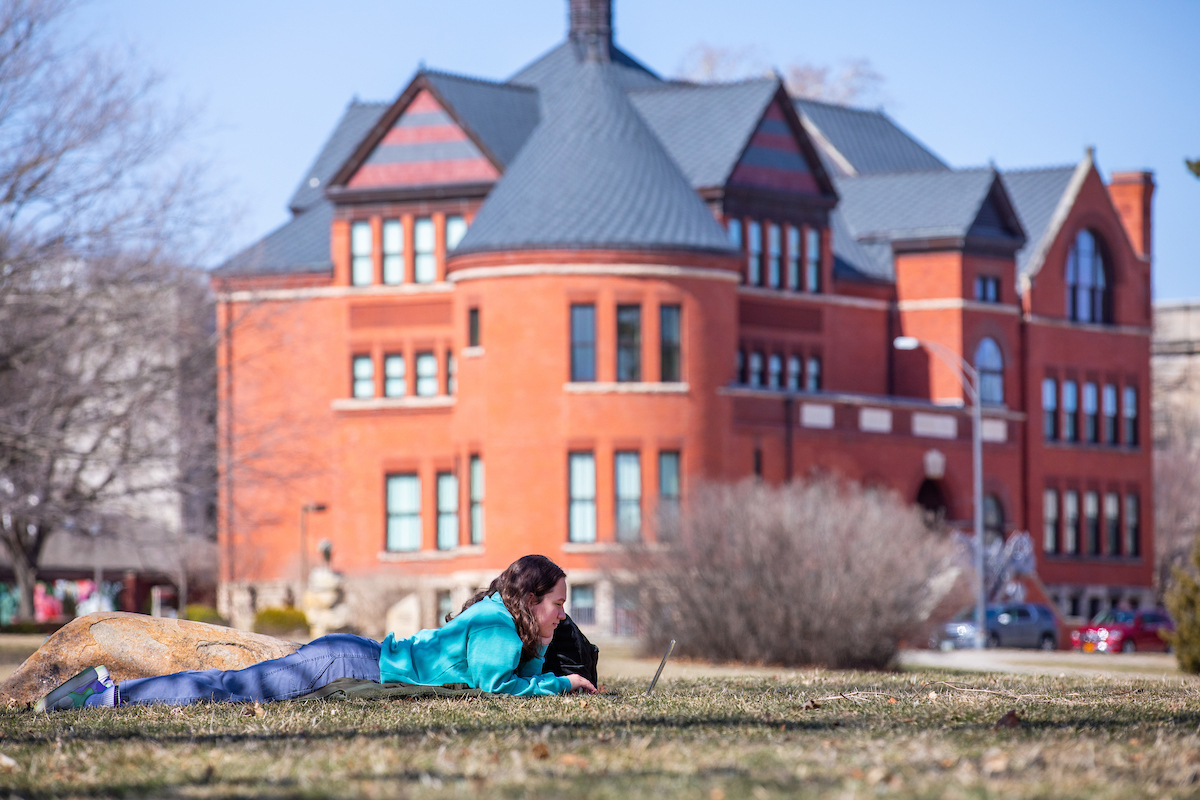
Photos by Christopher Gannon.
(Above) Iowa State junior Jaiden Jarmosco, who's majoring in communications and women and gender studies, studies outside in Monday's warm temperatures on the first day of spring on central campus. (Below) Cade Bradford, a freshman computer science major, soaks up some sunshine while working on calculus homework in the Anderson Sculpture Garden adjacent to Morrill Hall. His studious ways are mirrored by part of Christian Petersen's Library Boy and Girl.
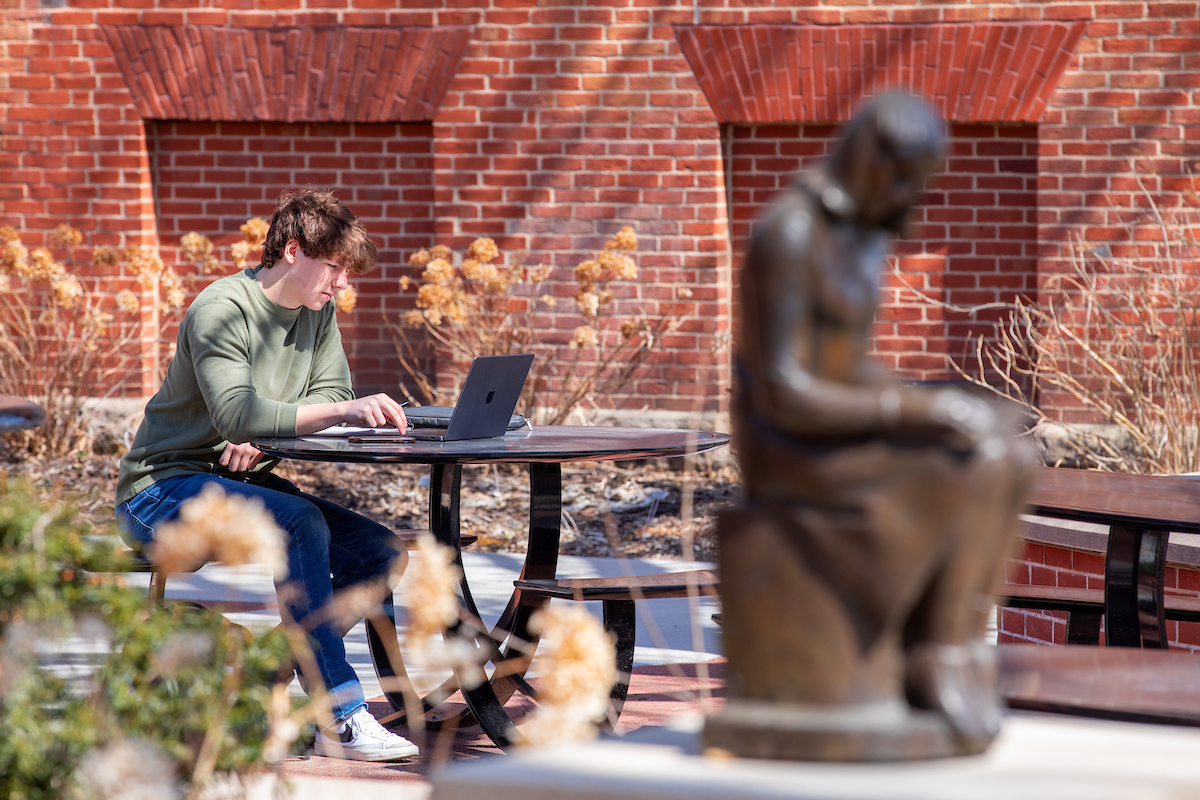
In case you missed it
As we begin the second half of the semester, here are a couple of news items you may have missed over spring break.
State Board of Regents plans review of DEI programs
The state Board of Regents issued a statement over spring break announcing plans for a review of all diversity, equity and inclusion (DEI) programs at the three regent institutions.
The board directed the universities to pause the implementation of any new DEI programs until the study is completed. This directive does not apply to existing programs, events or activities at Iowa State, which will continue. University leaders are awaiting guidance on the scope of the review and how the universities will be engaged in the process.
The board, along with several other Iowa organizations, has registered against current state legislation that would prohibit funding for university DEI offices and officers. The bill has not passed the Iowa House or Senate. Similar legislation has been introduced by governing bodies in more than two dozen states.
In February, prior to the introduction of the legislation, President Wendy Wintersteen and the two other regent university presidents spoke to members of the Legislature's Education Appropriations Subcommittee about the need for additional state support (read the full story). During that meeting, Wintersteen emphasized Iowa State's long history of diversity and inclusion efforts and how necessary they are to prepare students for today's workforce.
Proposal process opens for strategic plan funds
Faculty and staff are invited to submit proposals by April 28 for projects that align with one or more of the strategic plan's aspirational statements and have the potential to move Iowa State forward in transformational ways. Funding decisions will be announced by late June, with funds available on July 1. This is the inaugural cycle and has an unusually short timeline. Senior advisor to the president Sophia Magill said the annual competitive process will be iterative, and anticipates launching the next one in the fall.
All ideas are welcome and may include new ideas for campus initiatives to support students, improve campus services or are research-related efforts. Proposals can be submitted through the website and should demonstrate how they will advance one or more components of Iowa State's mission.
Magill is holding a series of informational sessions this week, including Thursday, March 23 (2-3 p.m., Campanile Room, Memorial Union) for those interested in learning more about the inaugural RFP process for the nine-year strategic plan. Magill said a virtual session also will be scheduled soon, or members of the campus community may schedule short meetings with her; contact administrative assistant Sue Kessel, 294-2042.
Among the details Magill shared this week:
- Pending additional direction from the regents, proposals for projects to enhance DEI at Iowa State will be accepted.
- Funding for the projects comes from institutional funds set aside for priorities, Magill said. In the interest of not limiting ideas, she declined to suggest a funding ceiling. Noting "$10,000 may be transformative for some units; for others $500,000 is needed," she said proposals may include funding requests for up to three years. Continued funding in subsequent years would depend on progress, she said.
- The submittal form (linked from the strategic plan website) is on an IT service portal not available to the public. It must be completed in a single sitting. Magill encouraged people to review the form and work offline to draft responses, heeding the word limit on some questions. The form includes components such as a budget template, performance/success metrics and the option for partnerships -- internal or external, public or private entities. An individual can be the project leader on just one proposal. However, individuals can be team members on multiple proposals.
- For those who haven't read it, Magill encouraged a review of the full strategic plan document, available in a PDF. Appendix 1 (page 15) provides useful progress indicators used in Iowa State's annual progress report to the regents. She noted departments, colleges or academic disciplines also have metrics for success.
- This first annual RFP process shouldn't be confused with concurrent processes this spring for funds connected to several of the nine jump-start initiatives first announced last summer.
Senators learn about campus safety options
Associate vice president and chief of police Michael Newton spoke to the Faculty Senate about safety on campus amid numerous school shootings across the nation during the March 21 meeting.
Newton said being prepared before an incident is one of the most important things employees and students can do. Mental rehearsals provide an understanding of potential alternatives and planning takes the pressure off decisions that require immediate action, Newton said.
There are several safety trainings available to faculty and staff. They include:
- Recognizing and Reporting Disruptive Behavior: The focus is on recognizing the warning signs of disruptive and escalating behavior, as well as strategies for mitigating potential acts of violence before a problem becomes unmanageable, including techniques for deescalating an agitated person.
- Violent Incident Response Training: This training promotes an options-based response and teaches a flexible set of principles that can be adapted to any violent encounter. The emphasis is on Iowa State resources and response options, but the training can aid survival in any location.
- Office space assessment: This outreach educates faculty and staff about best practices for safety in their workspaces. It combines principles of crime prevention with environmental design and offers options for arranging an office space, adding elements of security and developing a plan for yourself and colleagues.
- Safety planning: For individuals or groups with an identified safety concern, this process helps identify tools and resources an individual already possesses to keep them safe and additional resources they may need. Safety planning is individualized and addresses emotional, psychological and physical safety risks.
"We work to provide a safe and secure environment for anyone who comes here," Newton said.
Newton also encouraged everyone on campus to download the Iowa State Safe app. It provides safety options and information about safety from across campus.
Call for proposals
Sophia Magill, senior advisor to the president, spoke to senators about a call for proposals for funding consideration under ISU's nine-year strategic plan. Proposals are for fiscal year 2024, beginning July 1.
Proposals will be accepted through 5 p.m. Friday, April 28. Faculty and staff members interested in applying for strategic plan funds are encouraged to attend a session on Thursday, March 23 (2-3 p.m., MU Campanile Room) to learn more about the process and get answers to their questions. Magill said a virtual webinar also is being planned to share information.
Magill said all proposals will be considered, including those that center on diversity, equity and inclusion (DEI). Last week, the state Board of Regents announced a pause in implementing new DEI programs.
"We are waiting for further guidance from the state Board of Regents on the review, but at this time we are not making any changes to our current programs or services," she said. "At this time, all proposals that could demonstrate a connection to the strategic plan will be permitted."
Dependent eligibility verification
University human resources director of benefits Ed Holland provided an update on the dependent eligibility verification project for the 4,075 employees who have a dependent on medical, dental or vision plans.
The project begins March 27. Employees have until June 2 to provide the required documents verifying dependents on their insurance. There is no penalty for having ineligible dependents who are removed, but they no longer will be covered beginning Jan. 1, 2024.
Election
Megan Myers (world languages and cultures) and Michael Bootsma (accounting) were elected as senate representatives to the athletics council for three-year terms.
Other business
Senators will vote next month on:
- Removing duplicate definitions regarding faculty conduct from one of two sections in the Faculty Handbook. This will help avoid conflicting information.
- Adding language to the Faculty Handbook to ensure tenure and term faculty are eligible for Distinguished, University and Morrill Professorships. Changes to term faculty titles made years ago are not reflected for these honors or ISU's idea of one faculty. All faculty who reach the highest level of advancement could be nominated and the criteria for the titles remain the same.
- Discontinuing the bachelor of science in biophysics in the College of Liberal Arts and Sciences. The meaning has shifted over decades, and the learning objectives align closely with a biochemistry degree with a biophysics specialization. The biophysics program has graduated one student since 2018.
Stay safe during severe spring weather
April showers might bring May flowers, but spring in Iowa can also bring floods, thunderstorms and tornadoes, sometimes simultaneously. Here's what you need to know about the potential for severe weather over the next few months.
Tornadoes
Chances are you learned about Iowa's location in Tornado Alley if you grew up in the Cyclone State. While Tornado Alley is not officially recognized by the National Weather Service (NWS), it's commonly used to describe a central area of the United States where tornadoes occur more frequently. There were 42 tornadoes in Iowa in 2022 -- 34 of those happened in the spring -- and Iowa experienced its first January tornado since 1967 this year when a funnel touched down northeast of Williamsburg.
When a tornado siren is activated during a tornado warning, take shelter immediately in a windowless room like a basement or bathroom. Make sure you know where the severe weather shelter area is located in your building.
Pull over and park if you are driving and debris begins flying around your vehicle. Make sure your seatbelt is buckled, keep your head below the windows and cover it with your hands or a blanket if possible. If you can exit the car safely, find a ditch or area lower than the road, lie down and cover your head.
Severe Weather Awareness Week
The NWS has designated March 27-31 as Severe Weather Awareness Week, an annual opportunity to increase awareness of severe weather that often includes a statewide tornado drill.
For more severe weather tips, visit the Environmental Health and Safety website and follow EH&S on Facebook and Twitter.
Thunderstorms
If you can hear thunder, lightning is close enough to hurt or even kill. If you are outside or have outdoor activities planned, postpone and take shelter immediately in a fully enclosed building -- or car with a metal top if you can't make it to a building -- even if it's not raining. Shelter in place until at least 30 minutes after the last rumble of thunder.
Don't use plumbing fixtures like showers or washing machines during the storm as water conducts electricity. Avoid metal objects like golf clubs and tools, and stay away from tall objects like trees and poles if you are still outside. Unless it's an emergency, don't use corded electronic devices -- stick to a cordless phone, cell phone or laptop if possible.
Derechos
Though the destructive wind storm that tore through Iowa in 2020 did not happen in the spring, 70% of all derechos in North America take place from May to August. The NWS does not issue derecho warnings as derechos are defined as wind events produced by severe thunderstorms, therefore a severe thunderstorm warning will be issued if a derecho is approaching. Safety guidelines for derechos are the same as for thunderstorms.
Floods
Costly and dangerous, floods are among the most frequent natural disasters. Floods can occur after heavy rain saturates the ground and flash floods can happen when water rises rapidly along a stream or low area. Those living in areas prone to flooding should keep emergency supplies on hand and be prepared to evacuate quickly.
Seek higher ground if a flash flood warning is issued in your area. Six inches of fast-moving water can knock you off your feet and cars can be swept away in less than two feet of moving water. Do not try to walk or drive through flooded areas or around barricades.
Oh no, snow
Spring technically started on March 20 this year, but that's no guarantee it won't continue to snow periodically until April (and even May if we're especially unlucky). While it's unlikely that significant accumulation will occur, don't put away your winter gear just yet.
Sustainability, surplus benefit from Iowa Waste Exchange partnership
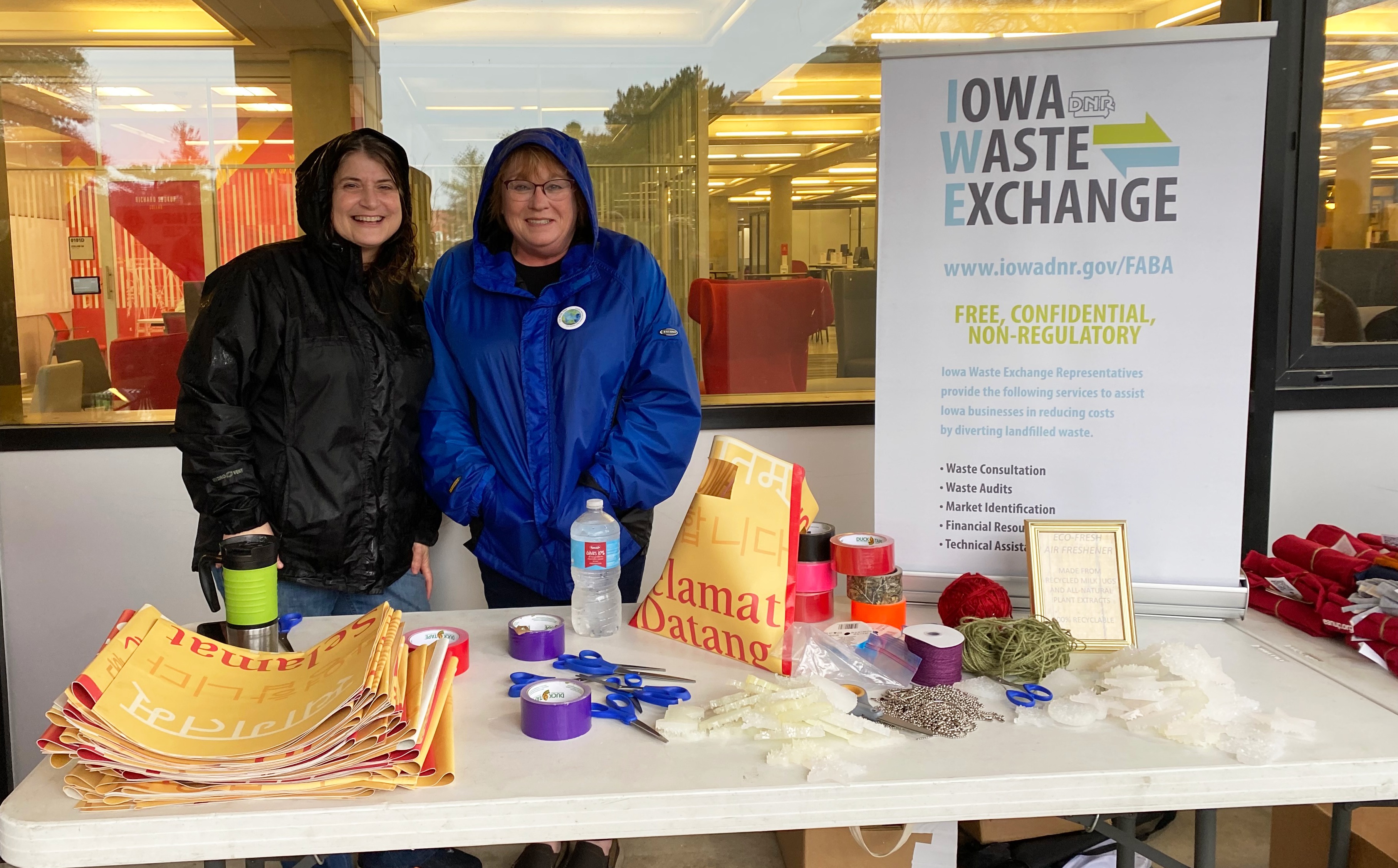
Merry Rankin and Shelly Codner outside Parks Library for a campus sustainability event, where used 'welcome' banners were repurposed for bags. Photos provided by Codner.
It was a few nights before Christmas when Shelly Codner, area resource specialist for the Iowa Waste Exchange (IWE), got a call from ISU surplus about finding homes for 200 mattresses by Jan. 2.
Used mattresses can't be sold without bed frames, and the vinyl-covered and bug-resistant mattresses needed to be manually disinfected before redistribution. ISU surplus manager Mark Ludwig reached out to longtime collaborator Codner with hopes of finding a solution that didn't end with the mattresses in a landfill.
This story has a happy ending -- the mattresses were received by Des Moines nonprofits Lopez Ministries and Serve Africa as part of a homebuilding project in Nimba County, Liberia -- and it's one of the many examples of how surplus and the office of sustainability have worked with the IWE to divert items from landfills and support another community.
Working together
Merry Rankin joined Iowa State as the director of sustainability in 2009, but her collaboration with Codner began before that -- their paths first crossed when Rankin worked at the Department of Natural Resources (DNR) and Codner at the Butler County Solid Waste Commission before moving to the IWE in 2003. The pair connected again during the demolition of Horticulture Hall's previous greenhouses in 2010 when Codner worked with Rankin to find homes for displaced plants.
About the IWE
The IWE is a free, confidential and non-regulatory service operated by the DNR that connects businesses with other organizations that can use or recycle their waste materials. IWE is part of a network of waste exchange programs in the United States and helps organizations reduce their environmental footprint while saving on disposal costs and creating new business opportunities.
Employees interested in working with the office of sustainability and IWE can contact Merry Rankin.
Rankin said Iowa State is multifaceted in the number and types of projects done and the different materials that need new places or uses to avoid being landfilled when new items are purchased or a project is completed.
"Everything from plants and flowers like we had during the greenhouse demolition years ago, to dressers from res life and even paper towel dispensers," she said. "There are so many backstories to the headlines we see about projects at the university that speak to our relationship with Shelly and the IWE."
Along with larger items like dressers and paper towel dispensers, Codner also takes smaller items -- like outdated banners, athletics magnets and posters -- and uses them for make-and-take workshops at events like Reusapalooza during the Iowa State Fair. Eventgoers can stop by the IWE table and convert posters and banners into tote and gift bags and pick up a refurbished magnet with an outdated athletic schedule replaced by fabric samples with ISU patterns.
"Taking materials that were once considered trash and creating a new item with value, especially when the items can go to those in need, is the most satisfying part of my job," Codner said.
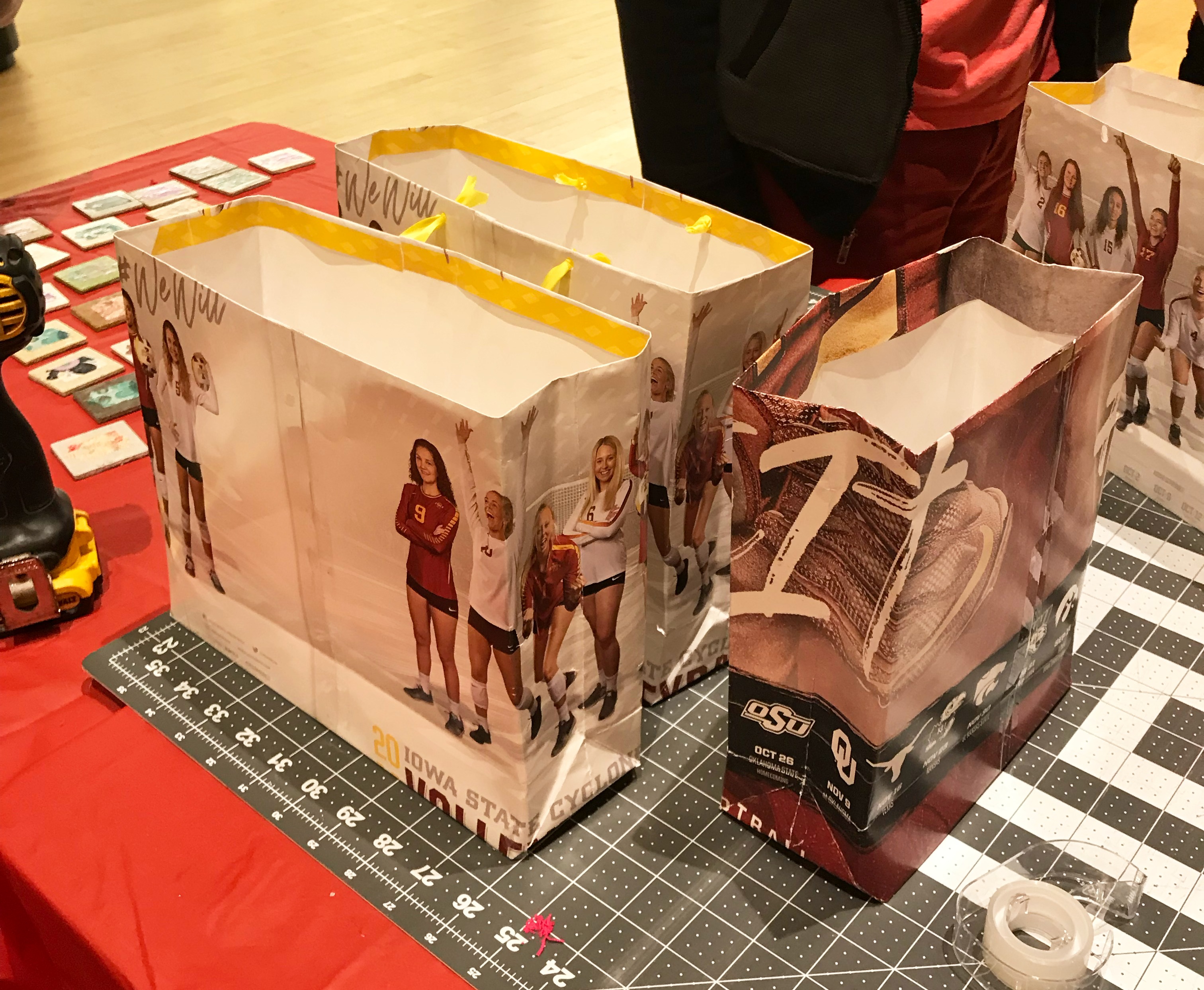
Codner created gift bags from outdated ISU athletic posters at a make-and-take workshop.
In addition to the cost savings of rehoming or reusing items versus paying to have them landfilled or recycled, Rankin said the ability to support the community, especially as a land-grant institution, is both meaningful and in alignment with the vision for sustainability at Iowa State.
"Sustainability relies on partnerships and collaborations that exist throughout our communities and organizations, and this connection with the IWE and Shelly has been invaluable," Rankin shared. "It elevates the importance of sustainability, from the standpoint of considering community, connecting community and supporting community -- it's been a win-win-win."
Surplus collaboration
Working with the IWE also has been beneficial for ISU surplus. When departments replace furniture, computers and other items, surplus collects the old items and determines if they can be:
- Sold
- Transitioned to another department, state-funded entity or tax-supported organization in Iowa
- Recycled
- Landfilled
That's where the IWE comes in.
"Our directive is to get the best return on investment for our assets," Ludwig said. "After we've made an attempt to sell items, then we can pursue other options to avoid sending things to the landfill."
It was the alternative route that led Ludwig to Codner in 2016. After reevaluating their policy on donating items to local nonprofits to increase transparency around the process, Ludwig connected with Codner about her work with nonprofits through the IWE. He learned that the IWE is part of the DNR in Iowa, opening the door for a partnership that aligned with the mission of surplus.
"Shelly has been a godsend when it comes to finding other avenues for assets we can't keep or sell," Ludwig said. "We'll get a nice thank you letter from a nonprofit every now and then and that helps us illustrate our added value and the value of this partnership."
Now plugged into Codner's network of nonprofits, Ludwig's team can find new homes for items with no resale value while keeping them out of landfills as much as possible. Ludwig said that even when some things ultimately have to be thrown away, working with the IWE has helped surplus shrink its environmental footprint more each year and cut costs on disposal fees.
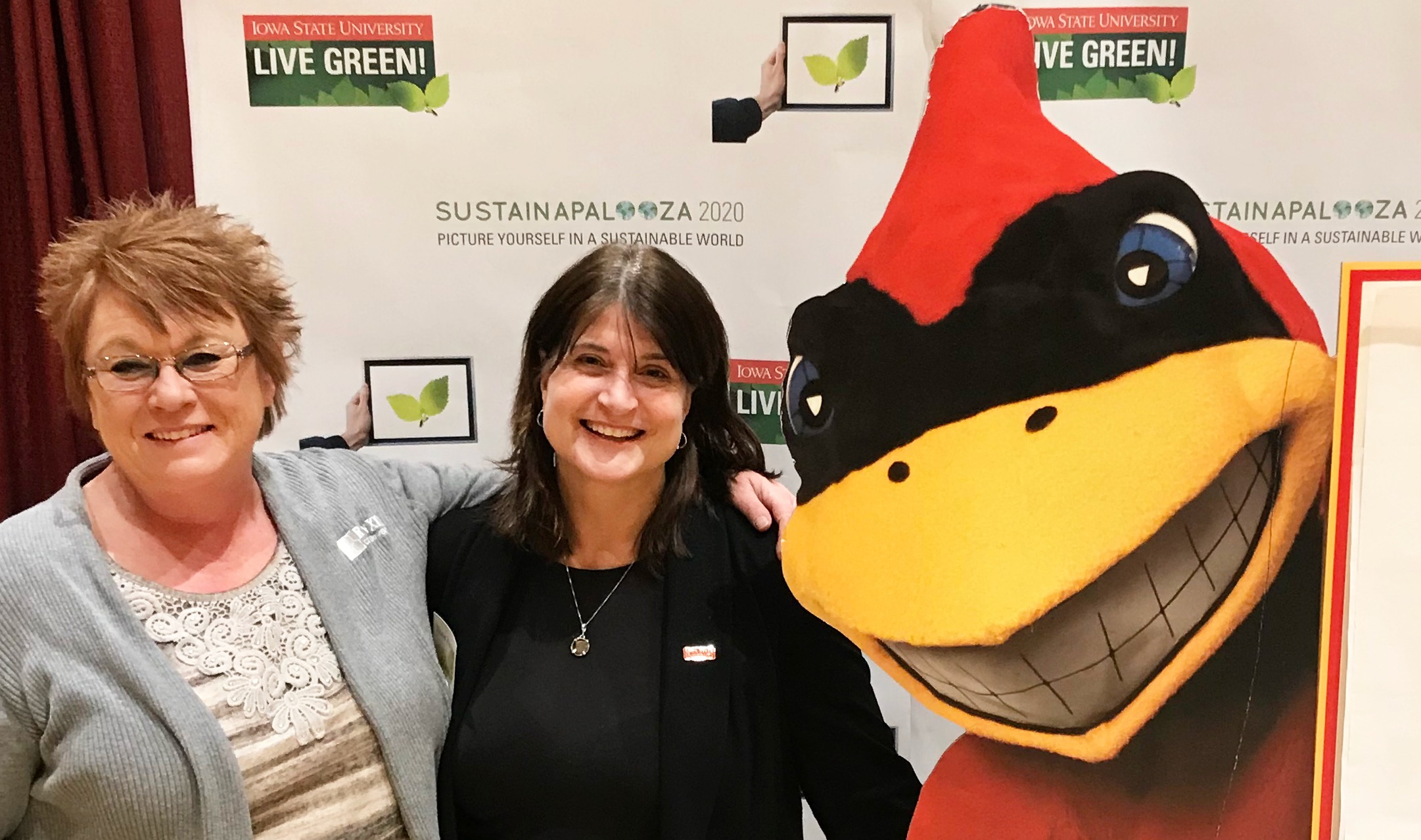
Codner, Rankin and Cy at Sustainapalooza 2020.
Doing your part
Similarly, shrinking that footprint as an individual starts with taking a first step and adding to it as you can -- it's not all-or-nothing, Rankin said.
Codner agreed.
"Reuse is awesome, recycling is awesome, but we always follow the waste management hierarchy. We need to reduce even as private citizens," she said. "We have these leftover things that we can make cool stuff with, but why do we have them in the first place? That's an important part of the IWE's message."
Congratulations, John Lawrence
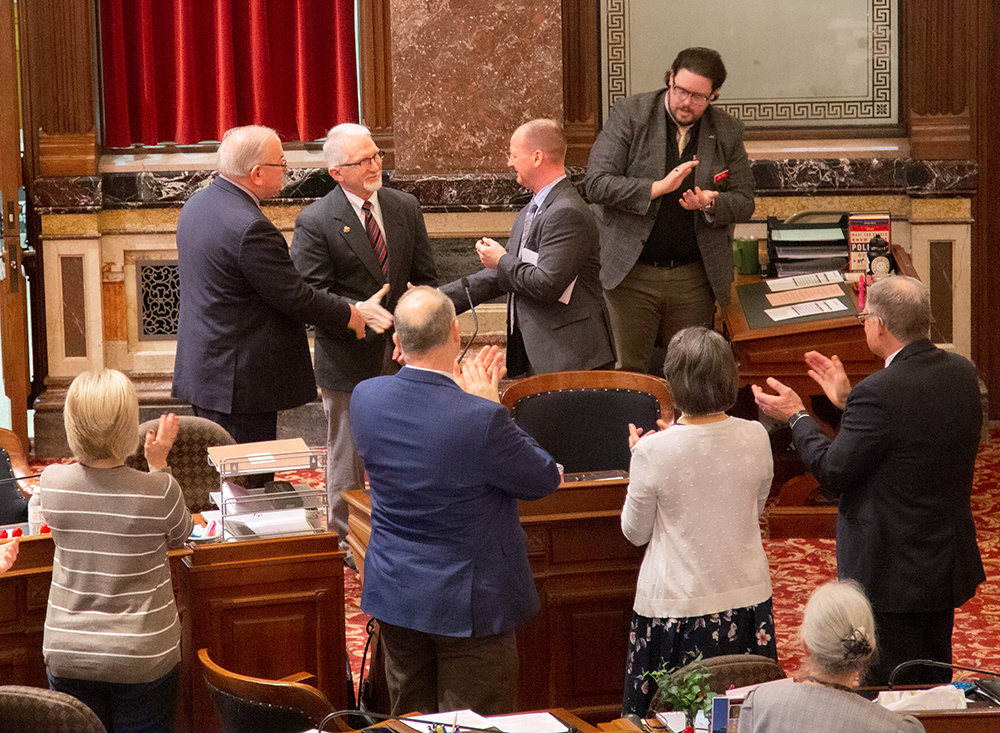
Photo by Amanda Karges, ISU Extension and Outreach.
The Iowa Senate approved resolution No. 6 on March 22, "honoring and congratulating John D. Lawrence for his years of dedicated service to Iowa State University of Science and Technology, the State of Iowa and all Iowans."
Congratulating Lawrence are (right) Sen. Jeff Edler, District 26 in central Iowa, and (left) the resolution's sponsor, Sen. Tom Shipley, District 9 in southwest Iowa, where Lawrence grew up. The two senators introduced Lawrence and read the resolution into the daily record.
Lawrence, a two-time alumnus and vice president for ISU Extension and Outreach, wraps up nearly 32 years of leadership and service to the university this spring.
ISU Theatre delves into Dungeons and Dragons
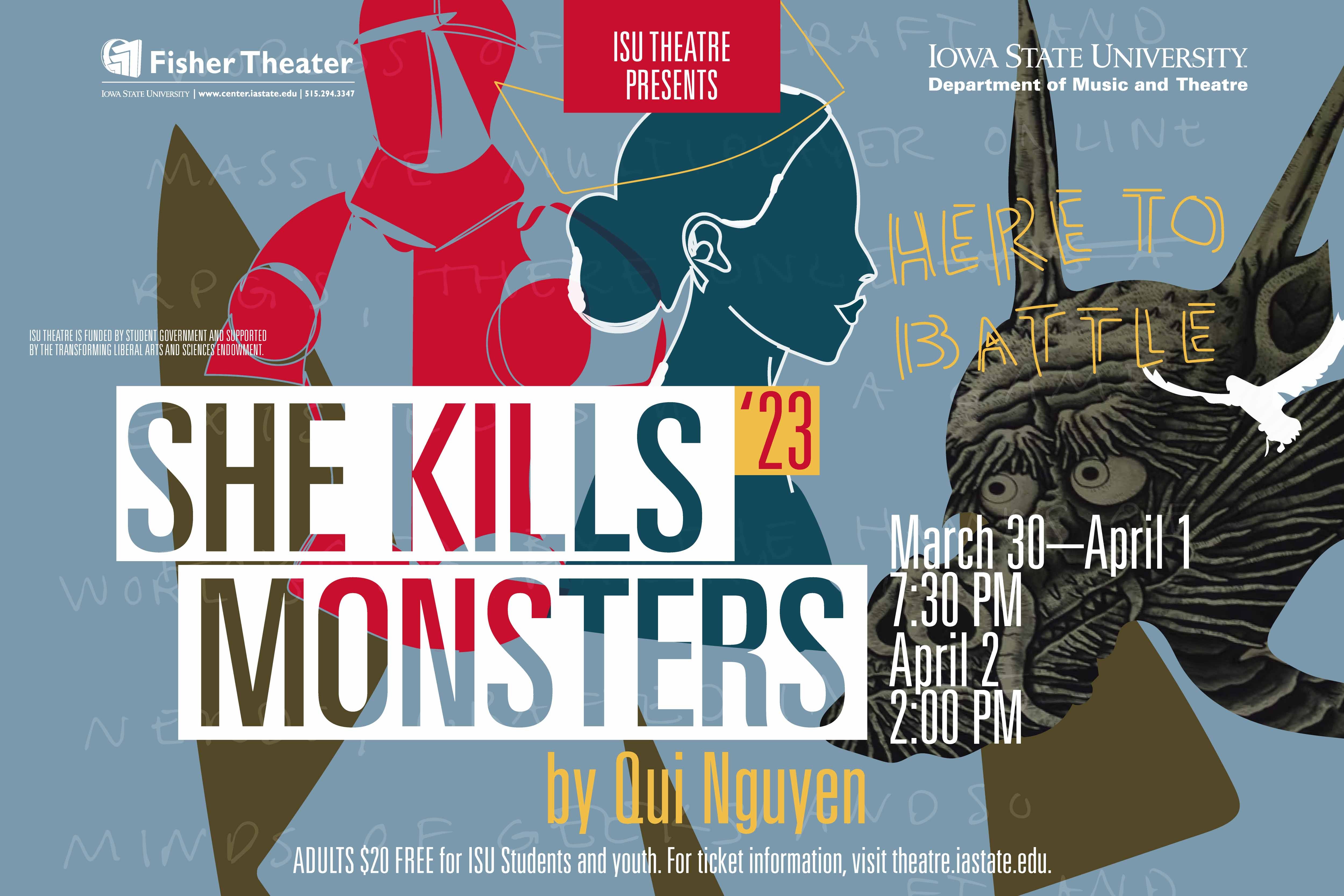
With its dance battles, giant dragon puppets, 1990s pop culture, homicidal fairies and nasty ogres, "She Kills Monsters" is described as "a heart-pounding homage to the geek and warrior within us all." The ISU Theatre dramatic comedy opens Thursday, March 30, at 7:30 p.m.
Penned by award-winning playwright, screenwriter and director Qui Nguyen, "She Kills Monsters" has become one of the most produced plays in the United States, from high schools to professional companies. The story follows a young woman, Agnes Evans, on a journey of grief and understanding as she begins to unlock mysteries about her deceased little sister Tilly. As Agnes pursues Tilly's secrets from their hometown of Athens, Ohio, into the thrilling world of Dungeons and Dragons, the show jumps between reality and action-packed fantasy.
Performances are March 30-April 1 at 7:30 p.m. and April 2 at 2 p.m. in Fisher Theater. Tickets are general admission ($20 for adults and free for Iowa State students and youth). This show contains adult language and content and flashing lights. For ticket information, visit theatre.iastate.edu.
Cason Murphy, assistant professor of theater and the play's director, said theater is perfect for telling a story involving role-playing games.
"The play is a clever, joyous celebration of the act of getting together with others, imagining wild scenarios full of vibrant, unique characters, and collaborating to craft a compelling, meaningful story, all while hoping a random roll of the dice doesn't completely derail the entire endeavor," Murphy said.
The magic behind a multiheaded dragon
A student puppeteer ensemble will create a fantastical game world on stage with large-scale puppetry designed by associate professor of theater Amanda Petefish-Schrag.
Mia Nollet, sophomore in environmental science, is the puppet captain leading the group. With such giant puppets, teamwork and safety are big priorities as it takes a group of eight puppeteers to operate the fearsome, multiheaded dragon puppet, Tiamat.
"In rehearsal, we use breathing to help us connect with each other," Nollet said. "Onstage, the puppeteers use group breathing, sound cues and our limited sight to operate our puppets, which has been a very fun challenge."
Petefish-Schrag said it's been exciting to see the students collaborate to create a single, unified character on stage.
Empathy, resilience, and community
Kaitlyn Meylor, who plays the role of Agnes, said the cast has the best camaraderie of any show she's been part of -- and she hopes that fun translates to the stage.
"I hope the audience laughs super hard at all the silly jokes we make, but I also hope to connect with them on an emotional level," she said. "This show means so much to me personally, and it has touched my heart in ways I can't begin to explain. I hope that it touches the hearts of the awesome people that come to see us as well."
While the show is sure to bring laughs -- and you don't need to be a Dungeons and Dragons fan to enjoy it -- Murphy said the play's themes of grief, queerness and quiet heroism also offer profound insight for these times. The story creates healing spaces for people facing individual loss or trauma and opportunities to celebrate human dignity and inclusivity.
